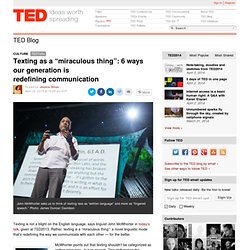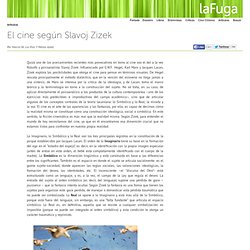

Texting is “miraculous”: 6 ways we are redefining communication. John McWhorter asks us to think of texting less as “written language” and more as “fingered speech.”

Photo: James Duncan Davidson Texting is not a blight on the English language, says linguist John McWhorter in today’s talk, given at TED2013. Rather, texting is a “miraculous thing”: a novel linguistic mode that’s redefining the way we communicate with each other — for the better. John McWhorter: Txtng is killing language. JK!!! If we think of texting as “fingered speech,” as McWhorter puts it, it also opens our eyes to texting’s distinct linguistic rules, structures and nuances. As the mediums through which we communicate quickly multiply, our modes of communication are following suit. Like “lol,” hashtags started out with a literal function: making topics easy to tag, and thus search for, on Twitter. John McWhorter was a part of TED’s worldwide talent search, giving a shorter version of his talk at the New York stop of the tour. The 10 best words the internet has given English. My book Netymology: A Linguistic Celebration of the Digital World is about the stories behind new words.

I've been an etymology addict since I was a teenager, and especially love unpicking technological words. It's a great reminder of how messily human the stories behind even our sleekest creations are – not to mention delightful curiosities in their own right. 1. Avatars This word for our digital incarnations has a marvellously mystical origin, beginning with the Sanskrit term avatara, describing the descent of a god from the heavens into earthly form. Fusing notions of virtual world-building and incarnation, it's the perfect emblem of computers as a portal to a new species of experience. 2.
In 1920s America, the # sign served as a shorthand for weight in pounds (and they still call it the pound sign). 3. Computing can be as much combat as collaboration between people and machines, and the Scunthorpe problem is a perfect example. 4. 5. 6. El cine según Slavoj Zizek : Quizá uno de los acercamientos recientes más provocativos en torno al cine sea el del a la vez filósofo y psicoanalista Slavoj Zizek.

Influenciado por G.W.F. Hegel, Karl Marx y Jacques Lacan, Zizek explora las posibilidades que otorga el cine para pensar en términos visuales. De Hegel rescata principalmente el método dialéctico, que en la versión del esloveno no llega jamás a una síntesis; de Marx se interesa por la crítica de la ideología; y de Lacan, toma el marco teórico y la terminología en torno a la construcción del sujeto.
El cine según Slavoj Zizek : Tres miradas al cine interactivo - Publicaciones ZEMOS98. La introducción de innovaciones técnicas puede deberse a multitud de factores, desde artísticos a puramente industriales, pasando por cuestiones de marketing y de evolución de la propia sociedad.

En definitiva, arte, industria y nuevas tecnologías configuran la realidad del cine en la actualidad. ¿Qué es el cine interactivo? Desde una perspectiva centrada en lo industrial podríamos decir que el cine interactivo, para las empresas del cine, fue un arma más en esa particular guerra que los productores, distribuidores y exhibidores de cine mantienen con el resto de medios de comunicación audiovisuales. Me refiero a la paulatina y constante pérdida de interés por la sala cinematográfica que tiene la audiencia desde que surgió la televisión. Máquinas de terror: cómo los videojuegos enfrentan nuestro subconsciente. Matt Gilgenbach/Neverending Nightmares.

Mi primera experiencia con el Oculus Rift no se aleja de un mal viaje de drogas psicodélicas, un preludio de un ataque de pánico. No estoy seguro de si esta ansiedad se deba un nerviosismo de primíparo, o si es causada por SoundSelf, un juego de realidad virtual que utiliza biofeedback para transportar a los usuarios hacia un estado alterado de la mente y el cuerpo. Estoy ansioso. Siento que me estoy acercando a un límite psíquico, como si estuviera justo en el borde del abismo, aturdido en las fauces de mi subconsciente. TIPOLOGÍA DE LOS SIGNOS DE CHARLES PEIRSE DE LA PAGINA DEL PROFE TOMÁS AUSTIN. Justo Villafañe - Introducción a la teoría de la imagen. How emoji became the first truly global language. Emoji: growing in complexity all the time.

I sent one this morning. My pal texted to say that she was in that most invidious of contemporary social tangles: someone was offering her a Kate Bush spare but she had already committed herself elsewhere. Me, I was busy thinking about emoji. I didn't have time to deal with someone else's heartache or their moral scruples vis-a-vis ditching an apparently iron-clad prior engagement. I scanned quickly through the available faces: there was one, all scrunched up in dismay about something or other. Obviously, I could have replied simply: "AAAARGH!!! ". But my timid scrunch-face puts me so behind the curve that I might as well start training carrier pigeons. Want to make yourself feel slightly nauseous and utterly baffled? All of which brings us a very long way from the end of the last millennium, when Japanese teenagers started using emoji on their pagers (the word itself consists of e-, picture, mo-, writing, ji, character). Beyoncé (feat.